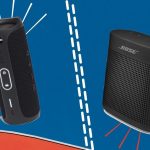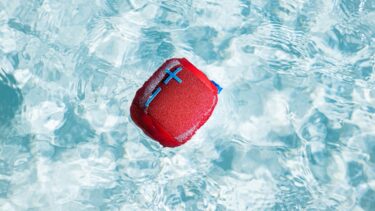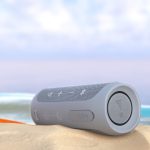This speaker is known for its range of cool colors. The fact that you can simply hook it to your backpack or carry it in your hands makes it worth pursuing. And well, it doesn’t cost much. But, which speaker cuts when it comes to overall performance? Should you buy the Bose SoundlLink Micro even though it’s over three years old? Well, that’s what we are going to answer in this post as we pit the JBL Go 3 against the Bose SoundlLink Micro in this comparison today. Since it’s going to be a long post, let’s get started, shall we? But first,
Here are the best budget computer speakers with BluetoothJBL Flip 5 vs UE Boom 3: Which external Bluetooth speaker should you buy
Specs That Matter
Design and Build
One of the first things that will strike you about the Bose SoundlLink Micro is its extremely flat shape and rubberized build. Looks-wise, the SoundlLink Micro doesn’t have much to boast about, but you can safely say that it’s durable. The rubberized exterior is soft to touch and makes it easy for the water to slide off should it get drenched in water. The grille covers half of the speaker’s front, while the controls occupy the other half. Overall, it’s a simple design, but the feature which makes it stand out from the rest is the silicon strap. This is no ordinary strap and is known to stand the test of time without breaking a sweat. For the record, it’s a tear-resistant strap that you can hook to your backpack or your bed-post. And guess what, the Bose SoundlLink Micro also has a bass radiator on its rear. Being a newer speaker, the JBL Go 3 packs a trendy design. And the dual-color tone gives it an attractive look. Unlike its predecessor, the new Go speaker is now sheathed in a durable fabric. And guess what, there’s a fabric strap as well that you can loop around your finger. The look is further accentuated by cool grips at the feet that help to keep it from tripping or falling. It’s worth noting that the JBL Go 3 can be placed on its back, thanks to its universal design. However, you might hear slight distortion in the bass when done so. Apart from that, the looks are pretty much simple. The build is solid, and as long as you take proper care of it, it will last you a long time. Do note that it also sports a rating of IP67, while the SoundlLink Micro has a rating of IPX7, making them both waterproof. Here, the JBL Go 3 has the added advantage of being dustproof as well. These days, the absence of speakerphone functionalities and AUX doesn’t seem surprising, with most makers opting to remove them. The Go 3 falls in this category and doesn’t have an AUX input or speakerphone abilities.
Battery and Connectivity
When it comes to battery life, both the SoundLink Micro and the JBL Go 3 doesn’t scale new height. With the advancement in battery tech, there are many portable (and affordable) speakers with a battery life of more than 10 hours. However, on this front, both the Go 3 and the SoundLink Micro disappoint slightly. While the SoundLink Mirco claims a playback time of 6 hours in moderate volume, the Go 3 has a battery life of around 5 hours on a full charge. So, these two speakers might not be the ones for you, especially if you are someone who often forgets to charge their phones or speakers. The odds are that the battery life will see you through a party or a day on the beach before needing a recharge. Of course, a lot depends on the volume levels as well. For instance, if you crank up the volume right from the start, you will need to top-up the battery sooner. Again, being an older speaker, the Spundlink Micro has a Micro-USB charging port instead of the new-age USB-C port of the Go 3. One of the main benefits of USB-C charging is the slightly faster-charging speed. The Go 3 takes around 2 hours for a full charge, while the SoundLink Micro can take up to 3-4 hours depending on the power source. But the good thing is that, if you are indoors, you can keep the speaker to charge while you listen to your favorite song. Last but not least, the Go 3 doesn’t support multi-device pairing, although it does support the latest version of Bluetooth. Surprisingly, the SoundLink Micro comes with Bluetooth Multipoint, thereby letting you have two connections at the same time. This removes the hassle of pairing and unpairing.
Audio Performance
One of the stand-out features of the Bose speaker is that it gets loud. It’s one of the predominant features of this speaker of this size. And that’s not all. This speaker delivers a considerably rich bass that can be considered good for casual use or parties, although this pocket-sized speaker is best heard in closed environments. However, it’s not perfect. For one, playing extremely bass-heavy songs may cause the speaker to distort slightly. On the other hand, the JBL Go 3 manages to do quite well for a speaker which is both small and affordable. You get both clarity and bass, and this balance is retained even when you crank up the volume. Just be careful to place it on its feet, and you should be sorted. The bass is rich, and at times, thumbs just right but you will have to ensure that the volume is not cranked up if you do not want distortion. But at the end of the day, the Go 3 doesn’t play well with low-bass and this can be an issue if you are a fan of bass-intensive music, or if you plan to watch action-packed movies by hooking your phone to this speaker.
Old vs New
Both the JBL Go 3 vs. Bose SoundlLink Micro prove to be great choices if you want speakers solely for outdoor use. They have a solid build, and the IP rating makes them apt to be used during any outdoor event, be it a pool party or a bike ride out in the trail. Of course, you won’t get nearly-perfect audio delivery like its premium counterparts like the Bose Portable speaker or the JBL Charge 4. Still, for its price, the audio delivery is decent. The JBL Go 3 makes a good buy if you want to buy a speaker for casual use without spending too much. It’s portable, and you can carry it anywhere, and the price isn’t on the higher end. However, the lack of low-bass means that you won’t be able to utilize it to watch movies or a fan of bass-heavy music tracks. On the other hand, the SoundlLink Micro is a good alternative. It’s loud, and both the high tones and low tones are balanced. If the slightly older make doesn’t bother you much, and you are all up for loud music, the SoundlLink Micro is the one for you. But do note that it costs almost double that of the Go 3. The above article may contain affiliate links which help support Guiding Tech. However, it does not affect our editorial integrity. The content remains unbiased and authentic.













